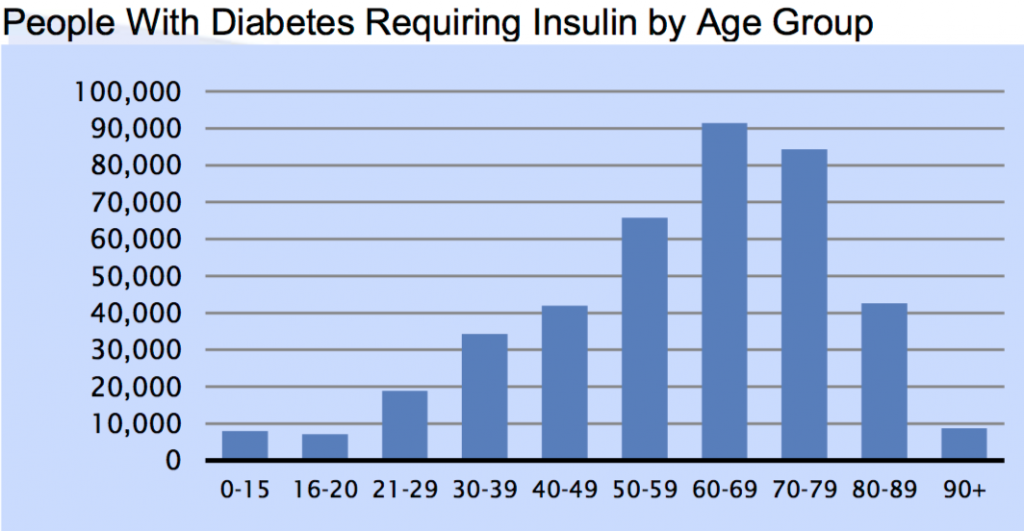As someone who lives with Type 1 Diabetes, I get on with regular life just with more complexity to deal with every day. But I’m not alone! To give you an overview of how widespread this condition is in Australia in 2018, I figured it was time for a recap.
The numbers I’m going to show here are extracted from the NDSS statistics for 31st March 2018. They provide us with a view of how many people with diabetes there are in Australia. There will of course be updated quarterly numbers available a month from now, but these are what I have to go on now.
High level statistics
In Australia there were 1,273,693 people with diabetes. Yes, that’s over 1.25 million Australians. Over 5% of the country!
Of these 9% (118,776) had Type 1 diabetes. I’m one of those people. Another 4% were classed as “Gestational” and “Other”, with the remaining 87% (1,107,289) having Type 2 diabetes.
Different Types of diabetes
Many people think that the distinctions between T1D and T2D are simple, and think things like:
- Only people with T1D need insulin. NOT TRUE.
- T1D is a “kids-only” disease. NOT TRUE.
- T2D is caused by lifestyle. NOT TRUE: many fit and otherwise healthy people develop T2 diabetes.
In very broad strokes, T1D is caused by the body’s own immune system destroying those cells which produce insulin, while T2D involves the body not being able to fully process the insulin it produces. There seem to be genetic factors (and many more of course!) involved in both.
There are of course other variants of diabetes. Someone who has their pancreas removed or damaged will end up with diabetes, plus there are MODY, LADA, and other forms. I’m not going to cover all that here. Unfortunately still more people don’t realise there are different types, and think all diabetes is because you ate too many sweets. Again, NOT TRUE.
Type 1 population
In April 2017 the Australian government delivered on an election promise and introduced fully-funded continuous glucose monitoring (CGM) for T1 kids up to 20 years old. It’s worth noting that:
- 88% of Australians with Type 1 Diabetes are older than this!
- All other health subsidies involve co-payments. For some political reason it was decided to apply a 100% subsidy in this case.
That’s right: only 12% of the Type 1 population can access this CGM scheme, irrespective of their income. Sometimes it feels as though many people seem to forget about the 103,705 people with T1D who are older than 20.
CGM is a significant tool which can massively improve the health, life prospects and quality of life for all people with diabetes. Unfortunately it’s currently expensive, which puts it out of reach of many of the people who would benefit from it the most. But that’s a different conversation than this one.
Insulin users
However, there’s more to the diabetes story than just the above. For example many people with other forms of diabetes also need to use insulin! Sure, all people with T1D do, but they’re not alone. Again, NDSS have a summary of this.
Of the total 1,273,693 people with diabetes, there were 402,597 people (32%) who need insulin therapy! This is over 1.5% of the Australian population.
We’re spread across all “types” of diabetes, with about 2/3rds of the insulin users having T2D.
We are a minority of Australians, but unfortunately we’re a growing segment of the population.



Heaps of interesting (and somewhat alarming) stats here, thanks David. I’m not above rioting for subsidised coverage of CGMs… Even if it was only the t1ds doing it, imagine all the windows 120k-odd of us could smash in rage? Just a thought….
Fantastic summary David. I hope the policy-makers see your page.
I wonder if we could get some health economists to do some stats weighing up the cost to the Australian government and health insurance companies of subsidising cgm with the long-term savings to the health budget due to a reduction in the need for treatment of diabetes complications such as eye, kidney, heart disease, charcot foot and amputations, as well as time off work cost for diabetes complications (productivity/GDP), early retirement on medical grounds and impacts on social security budget?
In the meantime, I do far fewer blood glucose tests since starting cgm. I would like to have the amount the government is saving on NDSS through not having to subsidise my ten BG strips per day applied as a subsidy to my cgm costs. That would help a bit.